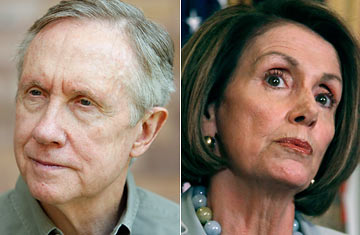
Senate majority leader Harry Reid, left, and House Speaker Nancy Pelosi
Democrats had hoped that passing health care reform would give them a much-needed bump in the polls ahead of this year's difficult midterm election; instead, their ratings have dipped, renewing worries about a political debacle in November. The worst-case scenario recalls the ghosts of 1994, when Newt Gingrich's Republicans took control of the House following the failure of the Clinton Administration's attempt at health care reform.
There are certainly parallels. In 1994, Bill Clinton's favorability poll numbers were at 51%, about where Obama's are now. And the Dems were polarized by a series of tough (and strikingly familiar) issues: a carbon tax, gays in the military and health care. But will history repeat itself, with the party in power bearing the brunt of a wave of discontent? Here are five reasons the 2010 midterm scenario is different, and perhaps less dire for the Democrats, than 1994's.
1. Michael Steele
For the Democrats, the Republican National Committee chairman is the gift that keeps on giving. Hardly a week goes by without some gaffe or scandal involving Michael Steele, from his threat to back primary challenges to moderate Republicans who supported the stimulus bill, to this week's episode in which a staffer was fired for taking young donors out for $2,000 worth of "meals" at a risqué lesbian-themed nightclub. That one had top GOP donors and groups such as the Family Research Council openly calling for a boycott of the RNC, urging supporters to instead give their money directly to candidates or congressional committees. At a time when Republicans should be celebrating their momentum, Steele is stealing headlines — and not in a good way.
2. Fundraising
Most polls may put the GOP ahead in voter enthusiasm, but that excitement has yet to translate into campaign cash. By the end of February, the National Republican Campaign Committee, which works to elect Republicans to the House, had slightly more than $6 million in the bank, compared with the nearly $20 million held by its Democratic counterpart. The Republican committee in the Senate that finances campaigns had $12.9 million on hand, compared with $14.3 million available to Senate Democrats. And the Republican National Committee trailed the Democratic National Committee, $9.5 million to $10.7 million. The war-chest gap in the House is the most notable, because that chamber is the one Republicans have the highest hopes of recapturing.
3. Tea Parties
While a lot of money is going directly to Republican candidates, they're not always the candidates the GOP would prefer to field. In Kentucky, for example, insurgent Tea Party darling Rand Paul has raked in nearly $2 million, outraising the establishment candidate, Kentucky Secretary of State Trey Grayson, by more than $100,000. In Florida, conservative insurgent Marco Rubio has raised more than $3.4 million and is leading Governor Charlie Crist, the presumptive Republican candidate, in the polls. To see the potential dangers of the Tea Party groundswell, the GOP leadership need look no further than the debacle in New York's 23rd district — where Democrats won a Republican safe seat after conservative activists put up a third candidate against Dede Scozzafava, a GOP candidate deemed too moderate by Tea Party types.
4. Who's the Leader?
In 1994, the GOP had Gingrich, an outsize personality whose Contract with America manifesto gave congressional Republicans a simple and accessible platform around which to rally voter discontent. This time, there's no clear-cut, dynamic leader to spearhead the charge and challenge Obama the way Gingrich challenged Clinton. On the other hand, in 1994 no one knew who Democratic House Speaker Tom Foley and Democratic Senate majority leader George Mitchell were. These days, the faces of Nancy Pelosi and Harry Reid are plastered all over GOP attack ads.
5. Legislative Wins
By November 1994, the Democratic presidency had been enfeebled by a series of disastrous setbacks. President Clinton decided right out of the gate to take on the polarizing issue of gays in the military, creating the widely unpopular "Don't ask, don't tell" policy. He also forced through the House an energy tax, known as the BTU tax, that would have charged all fuel sources based on their heat content; the measure failed in the Senate, and many vulnerable House Dems blamed that vote for the loss of their seats. And, of course, Clinton's attempt at health care reform tanked just before the 1994 elections.
By contrast, Obama has managed to pass the stimulus; is working on a bipartisan solution to DADT, which looks set to pass with relatively little controversy; and passed health care reform after a yearlong struggle. Whatever the bill's faults, health care is a big win. Indeed, many in the Obama Administration argue that all Dems would be far worse off right now if health care had failed.
"I have never seen two elections that were alike," says Charlie Cook, editor of the nonpartisan Cook Political Report. For all the similarities between 1994 and 2010, there are important differences. The current wave of voter discontent started in August 2009, 15 months before the election; in 1994, it began just three months before Election Day. Only time will tell if the health-reform-inspired wave of hostility to the Democrats will fade by November or if the Republicans will manage to keep the issue alive. For Democrats, the challenge now is to turn the nation's attention back to other concerns, like jobs. That points to another big difference between 1994 and 2010: in 1994 the unemployment rate was just under 6%; right now it's nearly 10%.
